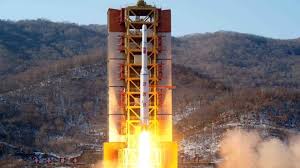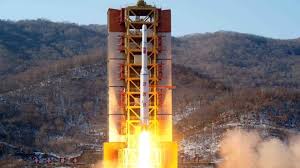
A move that could further strain U.S.-China ties and also hurt relations between Beijing and Seoul, a buildup of U.S. missile defense systems in Asia could begin after North Korea's latest rocket launch, U.S. officials and missile defense experts said.
The United States and its allies see the launch as cover for Pyongyang's development of ballistic missile technology that could be used to deliver a nuclear weapon even as North Korea says it put a satellite into orbit on Sunday.
The commitment of eh US for the security of its allies South Korea and Japan were reiterated by Washington after the launch which came close to the heels of a nuclear test by North Korea on Jan. 6.
Talks about deploying the sophisticated Terminal High Altitude Area Defense system, or THAAD, to the Korean peninsula "at the earliest possible date" would begin formally between the United States and South Korea.
Due to worries about upsetting China, its biggest trading partner, South Korea had been reluctant to publicly discuss the possibility.
“Deep concern” was expressed by Beijing about a system whose radar could penetrate Chinese territory even as China is at odds with the United States over Washington's reaction to its building of artificial islands in the disputed South China Sea.
The Foreign Ministry said that China had made its position clear to Seoul and Washington.
"When pursuing its own security, one country should not impair others' security interests," spokeswoman Hua Chunying said in a statement.
Parts of Seoul's political establishment that remain wary of such a move could be won over and South Korea could have reached a tipping point by the North Korean rocket launch following last month's nuclear test.
Only North Korea would be the focus of THAAD if it was deployed to South Korea, said both the US and South Korean representatives.
The assurance was termed as “feeble” in an editorial in the Global Times, an influential tabloid published by the ruling Chinese Communist Party's official People's Daily newspaper.
"It is widely believed by military experts that once THAAD is installed, Chinese missiles will be included as its target of surveillance, which will jeopardize Chinese national security," it said.
It was considering THAAD to beef up its defenses, Japan which has been long concerned about North Korea's ballistic missile program, has previously said. The North Korean rocket on Sunday flew over Japan's southern Okinawa prefecture.
The Defense Ministry had no concrete plan to introduce THAAD, said the chief cabinet secretary Yoshihide Suga on Monday. However the ministry believed new military assets would strengthen the country's capabilities, Suga added.
The launch would give Japan momentum to deploy THAAD, said Riki Ellison, founder of the Missile Defense Advocacy Alliance.
Washington is now studying the possibility of converting a Hawaii test site for a land-based version of the shipboard Aegis missile defense system into a combat-ready facility even as it had moved one of its five THAAD systems to Guam in 2013 following North Korean threats.
(Source:www.reuters.com)
The United States and its allies see the launch as cover for Pyongyang's development of ballistic missile technology that could be used to deliver a nuclear weapon even as North Korea says it put a satellite into orbit on Sunday.
The commitment of eh US for the security of its allies South Korea and Japan were reiterated by Washington after the launch which came close to the heels of a nuclear test by North Korea on Jan. 6.
Talks about deploying the sophisticated Terminal High Altitude Area Defense system, or THAAD, to the Korean peninsula "at the earliest possible date" would begin formally between the United States and South Korea.
Due to worries about upsetting China, its biggest trading partner, South Korea had been reluctant to publicly discuss the possibility.
“Deep concern” was expressed by Beijing about a system whose radar could penetrate Chinese territory even as China is at odds with the United States over Washington's reaction to its building of artificial islands in the disputed South China Sea.
The Foreign Ministry said that China had made its position clear to Seoul and Washington.
"When pursuing its own security, one country should not impair others' security interests," spokeswoman Hua Chunying said in a statement.
Parts of Seoul's political establishment that remain wary of such a move could be won over and South Korea could have reached a tipping point by the North Korean rocket launch following last month's nuclear test.
Only North Korea would be the focus of THAAD if it was deployed to South Korea, said both the US and South Korean representatives.
The assurance was termed as “feeble” in an editorial in the Global Times, an influential tabloid published by the ruling Chinese Communist Party's official People's Daily newspaper.
"It is widely believed by military experts that once THAAD is installed, Chinese missiles will be included as its target of surveillance, which will jeopardize Chinese national security," it said.
It was considering THAAD to beef up its defenses, Japan which has been long concerned about North Korea's ballistic missile program, has previously said. The North Korean rocket on Sunday flew over Japan's southern Okinawa prefecture.
The Defense Ministry had no concrete plan to introduce THAAD, said the chief cabinet secretary Yoshihide Suga on Monday. However the ministry believed new military assets would strengthen the country's capabilities, Suga added.
The launch would give Japan momentum to deploy THAAD, said Riki Ellison, founder of the Missile Defense Advocacy Alliance.
Washington is now studying the possibility of converting a Hawaii test site for a land-based version of the shipboard Aegis missile defense system into a combat-ready facility even as it had moved one of its five THAAD systems to Guam in 2013 following North Korean threats.
(Source:www.reuters.com)





